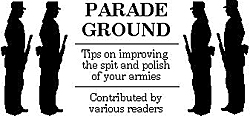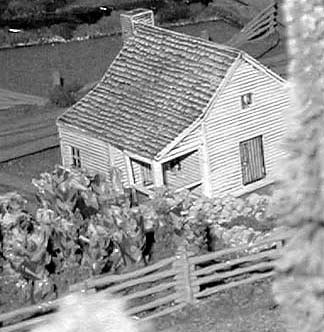 I primarily game the American Civil War Eastern theater (naturally, since I live so close to Gettysburg and Antietam) as well as the American Revolution. Battles of these periods were often fought in rural areas, many times dotted with working farms. To model this terrain, I have made hay fields, barley fields, oat fields, and wheatfields. One key element of the terrain of the period was the frequent cornfields that provided slight cover to troops, as well as slowing movement of formed units such as battle lines. For regimental-level and skirmish-level gaming of this period, cornfields become a key part of the tactics of battle.
I primarily game the American Civil War Eastern theater (naturally, since I live so close to Gettysburg and Antietam) as well as the American Revolution. Battles of these periods were often fought in rural areas, many times dotted with working farms. To model this terrain, I have made hay fields, barley fields, oat fields, and wheatfields. One key element of the terrain of the period was the frequent cornfields that provided slight cover to troops, as well as slowing movement of formed units such as battle lines. For regimental-level and skirmish-level gaming of this period, cornfields become a key part of the tactics of battle.
Model cornfields can be purchased through model railroad dealers (Bernie Kempinski has a fine line of etched brass cornstalks often seen on elaborate railroad layouts). For the wargamer, Musket Miniatures sells pewter cornstalks and a resin base (replete with a small scarecrow!). Doug Kline of Battlefield Terrain Concepts, Roanoke, VA, sells a line of wonderful hand-made corn squares in both 15mm and 25mm for gamers who wish to make portable, movable cornfields where the squares can be set aside as troops move through the fields. Doug also sells flattened cornfield squares to place down after the troop stands have moved on, having ruined the farmer's yield.
 I decided to take a stab at making my own cornfields for Civil War games where large volumes of corn are needed (for example, Miller's Cornfield at Antietam or the large cornfield at Chantilly where Phil Kearny died). While these are not as nice as Doug's professional pieces, for high volume, low cost areas, the following process will yield a decent crop of model corn.
I decided to take a stab at making my own cornfields for Civil War games where large volumes of corn are needed (for example, Miller's Cornfield at Antietam or the large cornfield at Chantilly where Phil Kearny died). While these are not as nice as Doug's professional pieces, for high volume, low cost areas, the following process will yield a decent crop of model corn.
Here are the steps I used...
- 1. Obtain a supply of small Christmas wreaths. I bought mine at the local Dollar Tree discount store for one dollar per wreath. Make sure that you get the kind with metal wire cores and flat cloth- like "needles." These work much better than the plastic kind.
2. Using wire cutters, remove each "branch" from the wreath and lay them aside.
3. For each branch, carefully trim away 90-95% of the "needle" material using a pair of sharp scissors. Leave enough of the needle material to simulate corn blades. The clipped needle material could be used for gaming purposes (grass?) if cut short enough, so you may wish to save this raw material for a future project.
4. With the wire cutters, cut the trimmed branch to the length desired for the cornstalks. This will depend upon your figure scale as well as the time of the year that the corn is representing. For 15mm gaming, I recomend cutting the branch into 1" lengths (for late August corn), using smaller lengths for earlier corn. Corn stalks in 25mm should be 1.5"-1.75".
5. There are several options to base the model corn stalks. For rolling terrain, sculpt a section of blueboard or pink EPS board into the shape desired. Paint the field in an earthtone depending upon the region of the country being modeled. Using a branch piece, poke holes in the foam in the location of the cornfield, spacing each stalk roughly a quarter inch apart in parallel rows. Glue each stalk into place. For movable corn rectangles, cut a base (balsa wood or other) measuring 1"x1.5" or any other size that you prefer. Permanently attach a series of corn stalks in parallel rows.
6. Note that in some areas of the early U.S., corn was not planted in rows, but rather in individual mounds in a checkerboard pattern. This can also be simulated instead of making orderly corn rows.
7. Once the corn stalks have dried and are attached firmly to the base, mix some goldenrod paint (or similar shade) and paint the tops of each stalk to resemble tassels. For late corn (October harvest), paint the entire corn stalk this color.
8. Finish each cornfield with any desired accessories (fencing, bushes, etc.).
9. For trampled cornfields, simply glue the corn stalks lying down on a base.
With a little practice, one Christmas wreath can be transformed into a square foot of cornfield. Not bad for a buck and some labor!
Back to The Herald 55 Table of Contents
Back to The Herald List of Issues
Back to MagWeb Master Magazine List
© Copyright 2003 by HMGS-GL.
This article appears in MagWeb.com (Magazine Web) on the Internet World Wide Web. Other articles from military history and related magazines are available at http://www.magweb.com